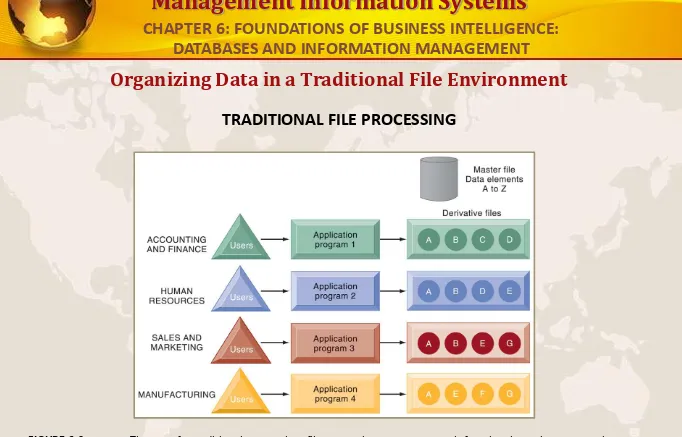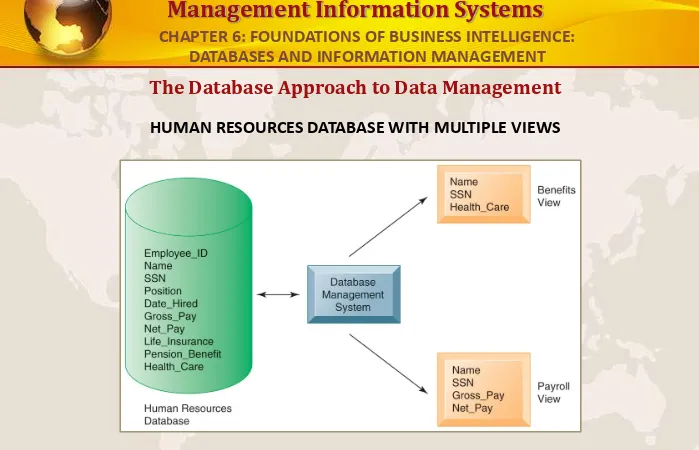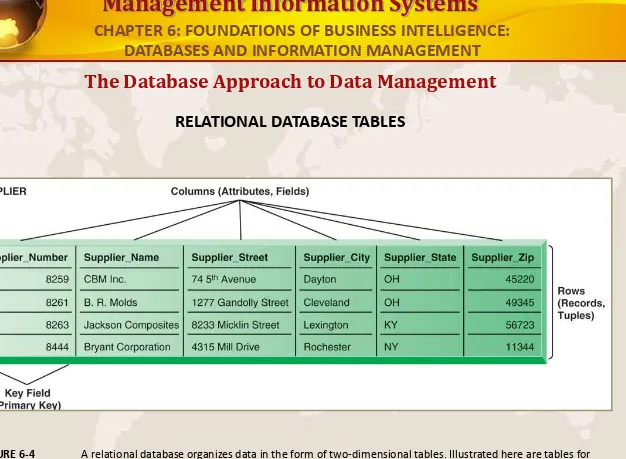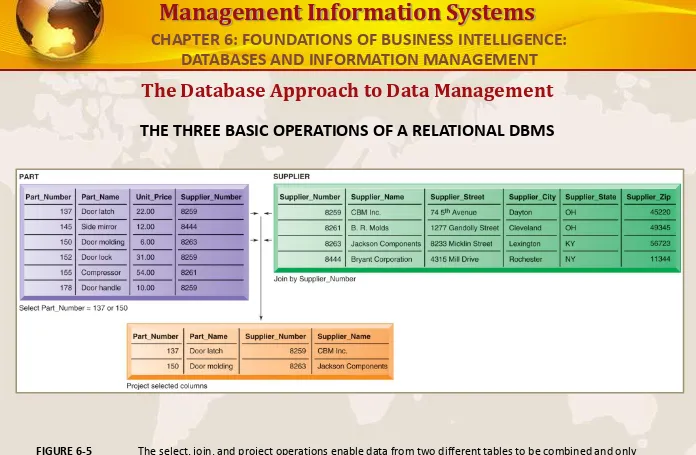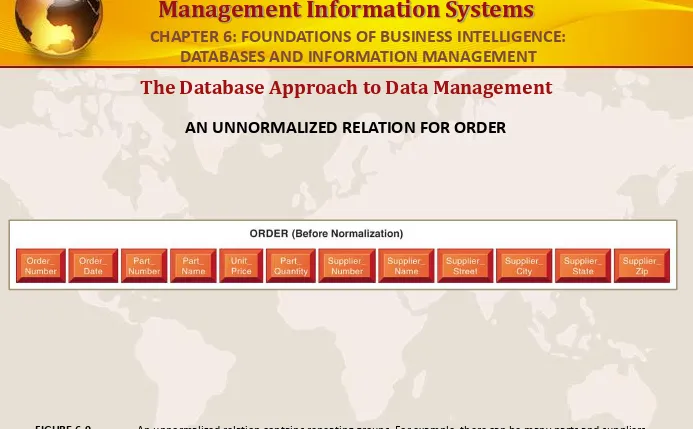Management Information Systems
MANAGING THE DIGITAL FIRM, 12
THEDITION GLOBAL EDITION
FOUNDATIONS OF BUSINESS
INTELLIGENCE: DATABASES AND
INFORMATION MANAGEMENT
Chapter 6
VIDEO CASES
Management Information Systems
•
Describe how the problems of managing data resources in a
traditional file environment are solved by a database
management system
•
Describe the capabilities and value of a database
management system
•
Apply important database design principles
•
Evaluate tools and technologies for accessing information
from databases to improve business performance and
decision making
•
Assess the role of information policy, data administration,
and data quality assurance in the management of a firm’s
data resources
Learning Objectives
Management Information Systems
•
Problem:
Explosive growth created information
management challenges.
•
Solutions:
Use MDM to create an enterprise-wide set of
data, preventing unnecessary data duplication.
•
Master data management (MDM)
enables companies like
R.R. Donnelley to eliminate outdated, incomplete or
incorrectly formatted data.
•
Demonstrates IT’s role in successful data management.
•
Illustrates digital technology’s role in storing and organizing
data.
RR Donnelley Tries to Master Its Data
Management Information Systems
•
File organization concepts
–
Database: Group of related files
–
File: Group of records of same type
–
Record: Group of related fields
–
Field: Group of characters as word(s) or number
•
Describes an entity
(person, place, thing on which we
store information)
•
Attribute: Each characteristic, or quality, describing
entity
–
E.g., Attributes Date or Grade belong to entity COURSE
Organizing Data in a Traditional File Environment
Management Information Systems
Organizing Data in a Traditional File Environment
THE DATA
HIERARCHY
A computer system organizes data in a hierarchy that starts with the bit, which represents either a 0 or a 1. Bits can be grouped to form a byte to represent one character, number, or symbol. Bytes can be grouped to form a field, and related fields can be grouped to form a record. Related records can be collected to form a file, and related files can be organized into a database.
FIGURE 6-1
Management Information Systems
•
Problems with the traditional file environment (files
maintained separately by different departments)
–
Data redundancy:
•
Presence of duplicate data in multiple files
–
Data inconsistency:
•
Same attribute has different values
–
Program-data dependence:
•
When changes in program requires changes to data
accessed by program
–
Lack of flexibility
–
Poor security
–
Lack of data sharing and availability
Organizing Data in a Traditional File Environment
Management Information Systems
Organizing Data in a Traditional File Environment
TRADITIONAL FILE PROCESSING
The use of a traditional approach to file processing encourages each functional area in a corporation to develop specialized applications. Each application requires a unique data file that is likely to be a subset of the master file. These subsets of the master file lead to data redundancy and inconsistency, processing inflexibility, and wasted storage resources.
FIGURE 6-2
Management Information Systems
•
Database
–
Serves many applications by centralizing data and
controlling redundant data
•
Database management system (DBMS)
–
Interfaces between applications and physical data files
–
Separates logical and physical views of data
–
Solves problems of traditional file environment
•
Controls redundancy
•
Eliminates inconsistency
•
Uncouples programs and data
•
Enables organization to centrally manage data and data security
The Database Approach to Data Management
Management Information Systems
The Database Approach to Data Management
HUMAN RESOURCES DATABASE WITH MULTIPLE VIEWS
A single human resources database provides many different views of data, depending on the information requirements of the user. Illustrated here are two possible views, one of interest to a benefits specialist and
one of interest to a member of the company’s payroll department.
FIGURE 6-3
Management Information Systems
•
Relational DBMS
–
Represent data as two-dimensional tables called relations or
files
–
Each table contains data on entity and attributes
•
Table: grid of columns and rows
–
Rows (tuples): Records for different entities
–
Fields (columns): Represents attribute for entity
–
Key field: Field used to uniquely identify each record
–
Primary key: Field in table used for key fields
–
Foreign key: Primary key used in second table as look-up field to
identify records from original table
The Database Approach to Data Management
Management Information Systems
The Database Approach to Data Management
RELATIONAL DATABASE TABLES
A relational database organizes data in the form of two-dimensional tables. Illustrated here are tables for the entities SUPPLIER and PART showing how they represent each entity and its attributes. Supplier Number is a primary key for the SUPPLIER table and a foreign key for the PART table.
FIGURE 6-4
Management Information Systems
The Database Approach to Data Management
RELATIONAL DATABASE TABLES (cont.)
A relational database organizes data in the form of two-dimensional tables. Illustrated here are tables for the entities SUPPLIER and PART showing how they represent each entity and its attributes. Supplier Number is a primary key for the SUPPLIER table and a foreign key for the PART table.
FIGURE 6-4 (cont.)
Management Information Systems
•
Operations of a Relational DBMS
–
Three basic operations used to develop useful
sets of data
•
SELECT:
Creates subset of data of all records that
meet stated criteria
•
JOIN:
Combines relational tables to provide user
with more information than available in individual
tables
•
PROJECT:
Creates subset of columns in table,
creating tables with only the information specified
The Database Approach to Data Management
Management Information Systems
The Database Approach to Data Management
THE THREE BASIC OPERATIONS OF A RELATIONAL DBMS
The select, join, and project operations enable data from two different tables to be combined and only selected attributes to be displayed.
FIGURE 6-5
Management Information Systems
•
Object-Oriented DBMS (OODBMS)
–
Stores data and procedures as objects
–
Objects can be graphics, multimedia, Java applets
–
Relatively slow compared with relational DBMS for
processing large numbers of transactions
–
Hybrid object-relational DBMS: Provide capabilities
of both OODBMS and relational DBMS
•
Databases in the cloud
–
Typically less functionality than on-premises DBs
–
Amazon Web Services, Microsoft SQL Azure
The Database Approach to Data Management
Management Information Systems
•
Capabilities of Database Management Systems
–
Data definition capability: Specifies structure of database
content, used to create tables and define characteristics
of fields
–
Data dictionary: Automated or manual file storing
definitions of data elements and their characteristics
–
Data manipulation language: Used to add, change,
delete, retrieve data from database
•
Structured Query Language (SQL)
•
Microsoft Access user tools for generation SQL
–
Many DBMS have report generation capabilities for
creating polished reports (Crystal Reports)
The Database Approach to Data Management
Management Information Systems
The Database Approach to Data Management
MICROSOFT ACCESS
DATA DICTIONARY
FEATURES
Microsoft Access has a rudimentary data dictionary capability that displays information about the size, format, and other
characteristics of each field in a database. Displayed here is the information maintained in the SUPPLIER table. The small key icon to the left of
Supplier_Number indicates that it is a key field.
FIGURE 6-6
Management Information Systems
The Database Approach to Data Management
EXAMPLE OF AN SQL QUERY
Illustrated here are the SQL statements for a query to select suppliers for parts 137 or 150. They produce a list with the same results as Figure 6-5.
FIGURE 6-7
Management Information Systems
The Database Approach to Data Management
AN ACCESS QUERY
Illustrated here is how the query in Figure 6-7 would be constructed using Microsoft Access query building tools. It shows the tables, fields, and selection criteria used for the query.
FIGURE 6-8
Management Information Systems
•
Designing Databases
–
Conceptual (logical) design: Abstract model from business
perspective
–
Physical design: How database is arranged on direct-access storage
devices
•
Design process identifies
–
Relationships among data elements, redundant database elements
–
Most efficient way to group data elements to meet business
requirements, needs of application programs
•
Normalization
–
Streamlining complex groupings of data to minimize redundant
data elements and awkward many-to-many relationships
The Database Approach to Data Management
Management Information Systems
The Database Approach to Data Management
AN UNNORMALIZED RELATION FOR ORDER
An unnormalized relation contains repeating groups. For example, there can be many parts and suppliers for each order. There is only a one-to-one correspondence between Order_Number and Order_Date.
FIGURE 6-9
Management Information Systems
The Database Approach to Data Management
NORMALIZED TABLES CREATED FROM ORDER
An unnormalized relation contains repeating groups. For example, there can be many parts and suppliers for each order. There is only a one-to-one correspondence between Order_Number and Order_Date.
FIGURE 6-10
Management Information Systems
•
Entity-relationship diagram
–
Used by database designers to document the data
model
–
Illustrates relationships between entities
•
Distributing databases: Storing database in more
than one place
–
Partitioned: Separate locations store different parts
of database
–
Replicated: Central database duplicated in entirety at
different locations
The Database Approach to Data Management
Management Information Systems
The Database Approach to Data Management
AN ENTITY-RELATIONSHIP DIAGRAM
This diagram shows the relationships between the entities SUPPLIER, PART, LINE_ITEM, and ORDER that might be used to model the database in Figure 6-10.
FIGURE 6-11
Management Information Systems
•
Very large databases and systems require special
capabilities, tools
–
To analyze large quantities of data
–
To access data from multiple systems
•
Three key techniques
1. Data warehousing
2. Data mining
3. Tools for accessing internal databases through the
Web
Using Databases to Improve Business Performance and Decision Making
Management Information Systems
•
Data warehouse:
–
Stores current and historical data from many core
operational transaction systems
–
Consolidates and standardizes information for use across
enterprise, but data cannot be altered
–
Data warehouse system will provide query, analysis, and
reporting tools
•
Data marts:
–
Subset of data warehouse
–
Summarized or highly focused portion of firm’s data for
use by specific population of users
–
Typically focuses on single subject or line of business
Using Databases to Improve Business Performance and Decision Making
Management Information Systems
The Database Approach to Data Management
COMPONENTS OF A DATA WAREHOUSE
The data warehouse extracts current and historical data from multiple operational systems inside the organization. These data are combined with data from external sources and reorganized into a central database designed for management reporting and analysis. The information directory provides users with information about the data available in the warehouse.
FIGURE 6-12
Management Information Systems
•
Business Intelligence:
–
Tools for consolidating, analyzing, and providing
access to vast amounts of data to help users make
better business decisions
–
E.g., Harrah’s Entertainment analyzes customers to
develop gambling profiles and identify most
profitable customers
–
Principle tools include:
•
Software for database query and reporting
•
Online analytical processing (OLAP)
•
Data mining
Using Databases to Improve Business Performance and Decision
Making
Management Information Systems
•
Online analytical processing (OLAP)
–
Supports multidimensional data analysis
•
Viewing data using multiple dimensions
•
Each aspect of information (product, pricing, cost,
region, time period) is different dimension
•
E.g., how many washers sold in the East in June
compared with other regions?
–
OLAP enables rapid, online answers to ad hoc
queries
Using Databases to Improve Business Performance and Decision
Making
Management Information Systems
The Database Approach to Data Management
MULTIDIMENSIONAL
DATA MODEL
The view that is showing is product versus region. If you rotate the cube 90 degrees, the face that will show is product versus actual and projected sales. If you rotate the cube 90 degrees again, you will see region versus actual and projected sales. Other views are possible.
FIGURE 6-13
Management Information Systems
•
Data mining:
–
More discovery driven than OLAP
–
Finds hidden patterns, relationships in large databases
and infers rules to predict future behavior
–
E.g., Finding patterns in customer data for one-to-one
marketing campaigns or to identify profitable customers.
–
Types of information obtainable from data mining
•
Associations
•
Sequences
•
Classification
•
Clustering
•
Forecasting
Using Databases to Improve Business Performance and Decision
Making
Management Information Systems
•
Predictive analysis
–
Uses data mining techniques, historical data, and
assumptions about future conditions to predict
outcomes of events
–
E.g., Probability a customer will respond to an
offer
•
Text mining
–
Extracts key elements from large unstructured
data sets (e.g., stored e-mails)
Using Databases to Improve Business Performance and Decision Making
Management Information Systems
Read the Interactive Session and discuss the following questions
•
What challenges does the increase in unstructured data
present for businesses?
•
How does text-mining improve decision-making?
•
What kinds of companies are most likely to benefit from text
mining software? Explain your answer.
•
In what ways could text mining potentially lead to the
erosion of personal information privacy? Explain.
Using Databases to Improve Business Performance and Decision Making
WHAT CAN BUSINESSES LEARN FROM TEXT MINING?
Management Information Systems
•
Web mining
–
Discovery and analysis of useful patterns and
information from WWW
•
E.g., to understand customer behavior, evaluate effectiveness of
Web site, etc.
–
Web content mining
•
Knowledge extracted from content of Web pages
–
Web structure mining
•
E.g., links to and from Web page
–
Web usage mining
•
User interaction data recorded by Web server
Using Databases to Improve Business Performance and Decision Making
Management Information Systems
•
Databases and the Web
–
Many companies use Web to make some internal
databases available to customers or partners
–
Typical configuration includes:
•
Web server
•
Application server/middleware/CGI scripts
•
Database server (hosting DBM)
–
Advantages of using Web for database access:
•
Ease of use of browser software
•
Web interface requires few or no changes to database
•
Inexpensive to add Web interface to system
Using Databases to Improve Business Performance and Decision Making
Management Information Systems
The Database Approach to Data Management
LINKING INTERNAL DATABASES TO THE WEB
Users access an organization’s internal database through the Web using their desktop PCs and Web browser
software.
FIGURE 6-14

